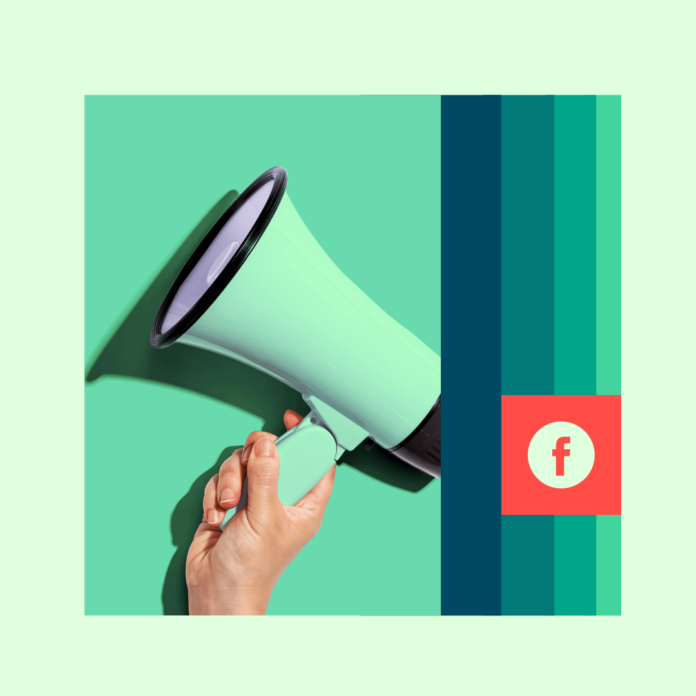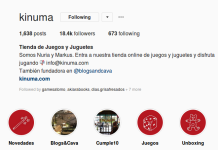Here’s a status update for you: Facebook marketing is still a necessity in 2023.
With a staggering 2.93 billion daily active users, Facebook still stands tall (on a foundation of all those Minions memes your uncle posted) as the world’s most dominant social media platform.
For 54.9% of Facebook users, the platform serves as their primary hub for researching brands. In fact, a remarkable 66% of all Facebook users routinely explore local business Pages at least once each week.
So if you’ve got a business brewing, it’s time to take the Facebook plunge. And we’re here to dive in with you, swimming (okay, yes, we’re sticking with the metaphor) through the process to start your Facebook marketing journey with a splash.
#1 Social Media Tool
Create. Schedule. Publish. Engage. Measure. Win.
Free 30-Day Trial
What is Facebook marketing?
Facebook marketing is the strategic promotion of a business or brand using the Facebook platform.
Facebook marketing can enhance brand recognition, expand your online audience, capture potential leads, and boost sales of products or services.
Facebook marketing tactics for business can include:
How to set up Facebook for business
There are plenty of advanced techniques and paid services you can incorporate into your Facebook business strategy, but before you get there, you need to have a Facebook Page for your brand.
Then, if you really want to take things to the next level from there, you can get your account verified and set up your Meta ad account… but let’s take this one step at a time.
Set up a Facebook Page for your business
1. Make sure you have a personal Facebook profile before you begin. Then, click on the Pages icon (flag) on the left-hand side of the site and click Create New Page.

2. Add your Page name and select the appropriate business category
3. Fill in your business bio information and click Create.
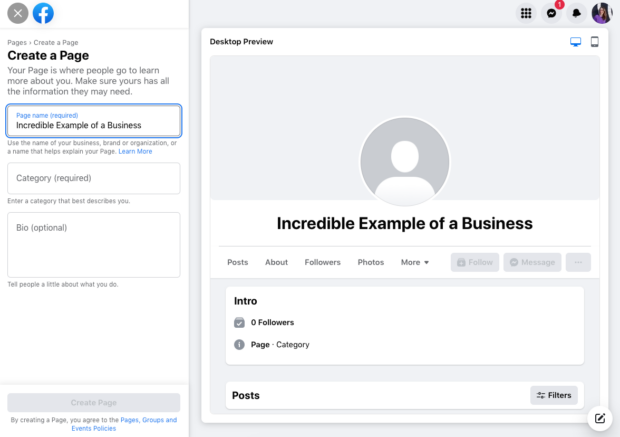
4. From here, you can fill in more details like contact and location; add profile and cover images; and edit the action button.
5. Invite your friends to follow your page, and click Next and then Done to publish your Page for all the world to see.
Find a more detailed breakdown of the Facebook Business Page creation process here.
Verify your Facebook Page for business
This is totally optional, but having a blue “verified badge” on your Facebook Business Page may be beneficial for your marketing strategy. Having a verified badge indicates that Facebook has confirmed that, yep, this page is the official, authentic Page representing your brand.
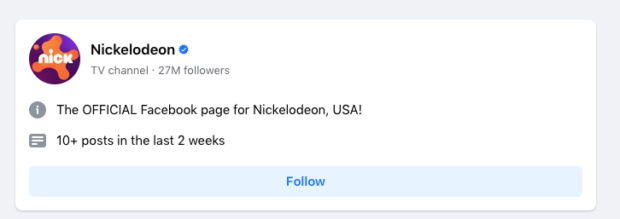
Seeing a verified badge can put customers and fans at ease; it exudes trust and authority (and helps stop imitators and scammers in their tracks)..
Before you apply for verification, make sure your Facebook Page meets all the requirements for a badge. Your Page must be…
- Authentic: Represent a real business.
- Unique: Make sure your business only has one Page operating because only one Business Page per brand may be verified (with the exception of language-specific versions).
- Complete: Fill out your About section and upload a Page photo. (Hot tip: You also should have at least one post on your Facebook Business Page before you apply for verification.)
- Notable: This one’s pretty subjective and tough to fulfill, but Meta basically needs to deem you… relevant! Is your business well-known? Does your brand have an existing reputation? If you’re a start-up with no other online presence or a long-running business that’s operated under the radar, you might have trouble convincing Meta that you need a verification badge.
All set? Just fill out this Verify Your Page form and then sit around with your fingers crossed, hoping the Meta overlords approve your request.
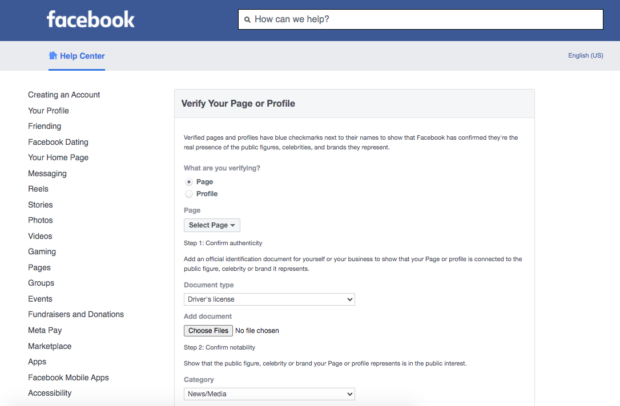
Dig deeper into the logistics of getting your business verified on Facebook here.
Start an ad account
While you can absolutely build a thriving Facebook presence with organic content alone, if you’re planning on spending a few bucks to boost posts or activate campaigns, you’ll need an ad account for your Facebook Page, too. Here’s how to set that up.
1. Go to Business Settings
2. Choose Accounts from the left-hand menu. Click Ad Accounts.
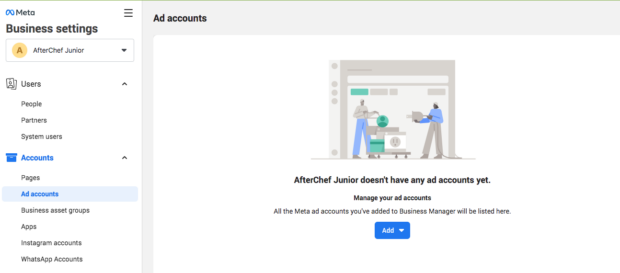
3. Click the Add dropdown menu (it’s blue), and pick “Create a new ad account.”
4. Follow the prompts from there!
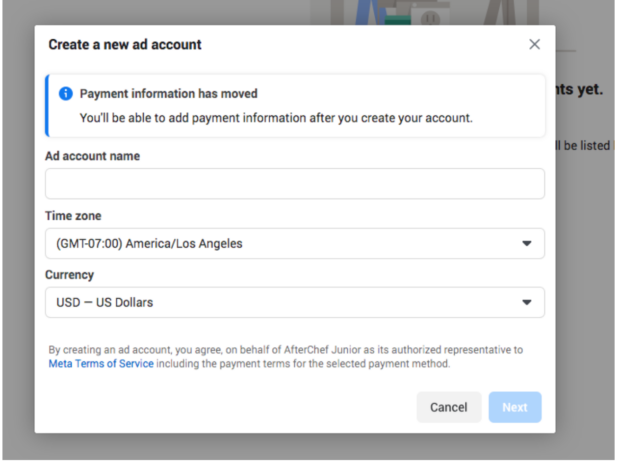
You’ve also got the option to add an existing ad account or request access to an ad account. Once that’s good to go, check out this list of 22 inspiring Facebook ad examples for ideas for your own winning campaign.
Types of Facebook posts to use for marketing
While Facebook posts of yore used to be limited to a single, verb-oriented status update (remember those heady, “Trevor is….” days?), there are tons of different formats to experiment with for your Facebook business marketing.
Text
Text posts still get a surprisingly high amount of engagement: 0.11%, according to this We Are Social study. (That may not seem very exciting, but the average engagement with any kind of Facebook Page post is a mere 0.07%.)
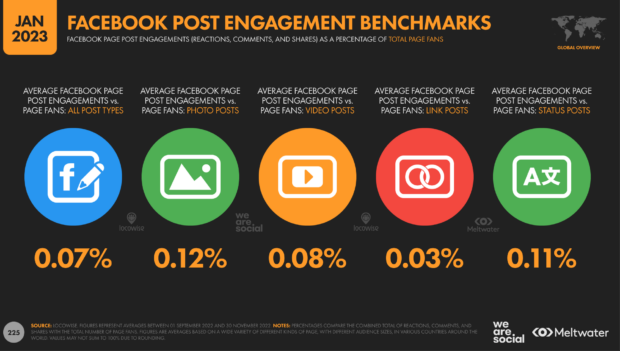
One theory: With everyone’s newsfeed so full of images and videos, text might be one way to actually stand out from the crowd. Keep it short and snappy for maximum impact. (A little humor doesn’t hurt, either.)
Photo
Photos are the most engaging type of post for Facebook Pages, so get snap happy, people.
A photo post can be any type of image: a picture, an infographic, or a piece of artwork. You can add multiple images to any photo post—up to 10, in fact. (If you want to group photos in a larger collection, consider making a Facebook album.)
Bonus: Download a free guide that teaches you how to turn Facebook traffic into sales in four simple steps using Hootsuite.
Some ways businesses can share images include…
- Show off images of your latest product or collection
- Share process photos
- Give followers a peek behind the scenes
- Share a compelling infographic about the impact of your service
- Spark inspiration with lifestyle shots
Limited photography budget? Check out these free stock photo sites.
Video
Videos are the bloodlife of social media in 2023, as TikTok has taught us. There are more than three billion internet users who consume video online daily—and yet video posts only make up 17.4% of all posts on Facebook Pages.

There’s no end to ideas for Facebook Page videos. Consider sharing:
- Interviews with experts
- Factory tours
- Product demos
- Explainer videos
- Event coverage
- Day-in-the-life videos
Give ‘em something to chew on, why don’t you?
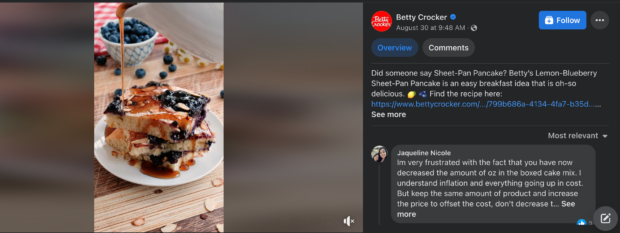
Wondering what successful social media videos have in common? Check our tips for creating viral social videos.
Link
When you post a link on Facebook, a preview image is auto-generated, so you’re going to get a real visual pop on your Page.
It’s also a great way to funnel your followers to what you really want them to do, whether that’s purchase a product, check out your blog post, visit your website, learn more about your improv show, watch your latest YouTube video, or participate in a survey.
While your presence on Instagram might be focused on building community and sharing content and information in-platform, Facebook is a helpful tool for directing your audience off of Facebook to where you actually want them to be.
Fundraiser
Throw your weight behind a good cause with a fundraiser post. Maybe there’s a cause that aligns well with your organization; maybe you’ve got a formal partnership with a great local charity. Either way, Facebook Pages feature an option to post fundraisers.
It’s a way to share your values with your followers, build some goodwill vibes, and, of course, help generate cash for those in need.
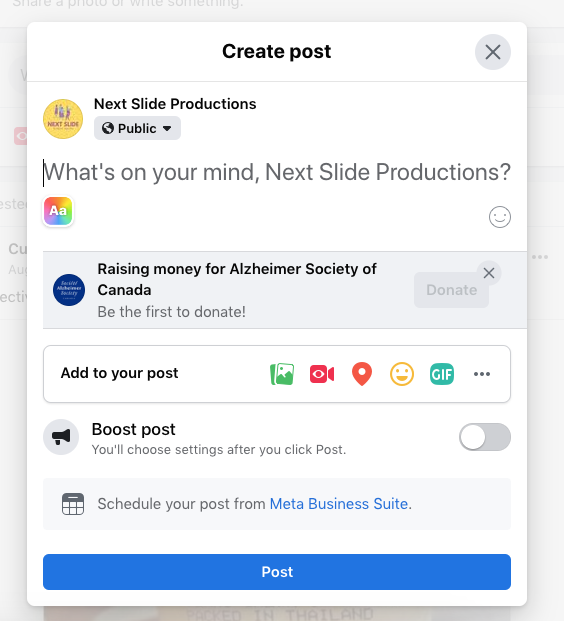
Messenger prompt
Similar to the Fundraiser post option, the Messenger option allows you to add a “Send message” action button to your post. If you’re looking to spark direct engagement in private convos with your followers, this is a unique, intimate way to go.
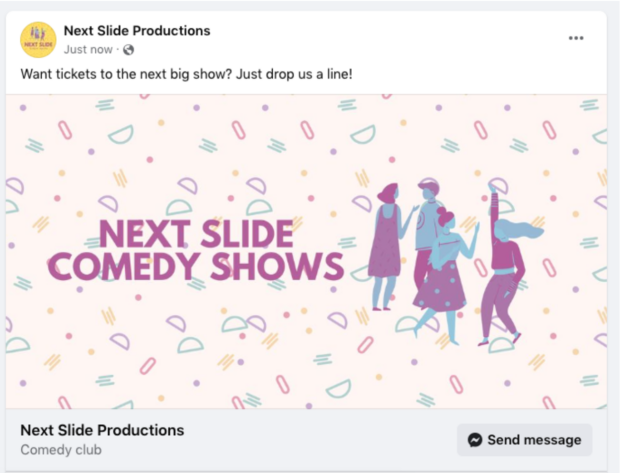
But be warned: you’d better be fast to respond if you go this route. Social media users expect extremely quick responses for customer service chat.
You may want to consider setting up a customer service chatbot to help manage the influx of messages that might come after a post like this.
Find more Messenger marketing strategies here.
Live-stream
Whether you’re sharing breaking news, broadcasting a live performance, hosting an interactive Q&A, or producing a panel discussion, social media live streams are a powerful way to capture audience attention and drive engagement.
For instance: this authentic, intimate, in-real-time makeup tutorial got 2,500 views. Bonus: Facebook Live videos live on your Page once the broadcast is over, so you can keep collecting those eyeballs even once the director has yelled “cut.”
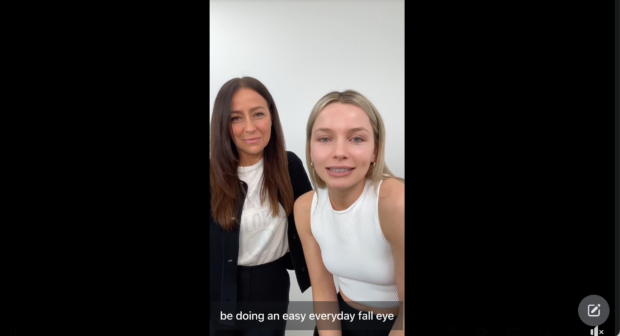
Here’s everything you need to know about going Live on Facebook.
Event
Invite your followers to turn off their computers and join you in the real world… or turn on their computers, um, even harder to attend an online event you’re hosting.
Facebook Events are another form of post you can make with your Facebook Business Page as part of your marketing strategy to turn passive scrollers into active participants.
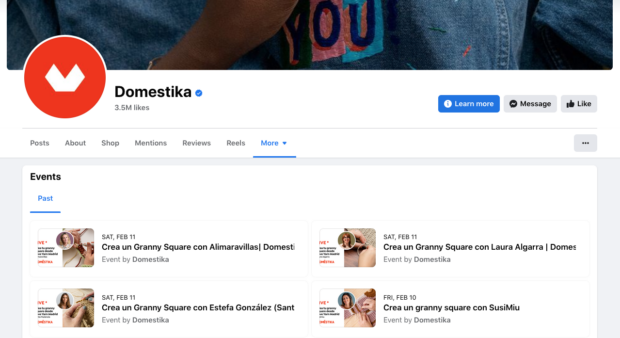
Stories
Just like Instagram Stories, Facebook Stories are fleeting images or videos designed to disappear after 24 hours.
After viewing a business’ Story, 58% of people say they’ve browsed a brand’s website, 50% say they’ve visited a website to buy a product or service, and 31% headed to a store to scope things out.
So while they may vaporize after a day, Facebook Stories may have a place in your social media strategy. (Plus, you can save them as highlights or turn them into Reels, so nothing ever has to be truly lost.)
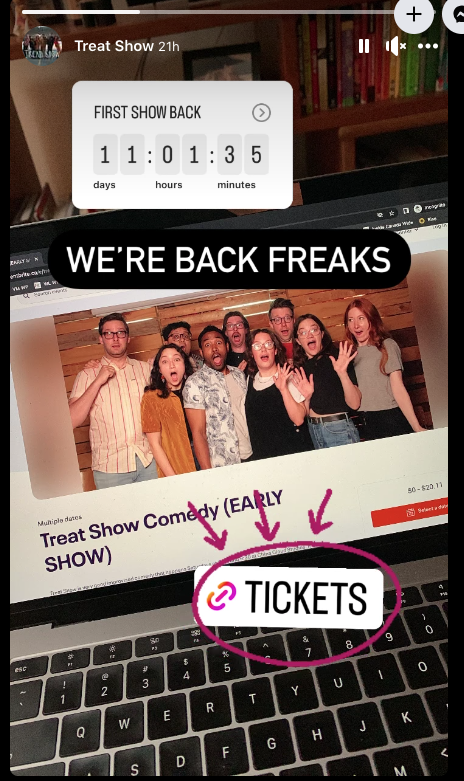
Stories can be found above Facebook’s news feed, both on desktop and in the app. They can also be posted and watched on the Messenger app.
Learn more about Facebook Stories here.
Reels
Short-form video is unavoidable at this point. First came TikTok. Then came Instagram Reels. It was inevitable Facebook would get into the game too. (Don’t get us started on YouTube Shorts.)
Facebook Reels are short-form videos (under 30 seconds) enhanced with tools like music, audio clips, and effects. They’re often used by content creators and influencers… but they could also be a lot of fun for your Facebook marketing strategy.
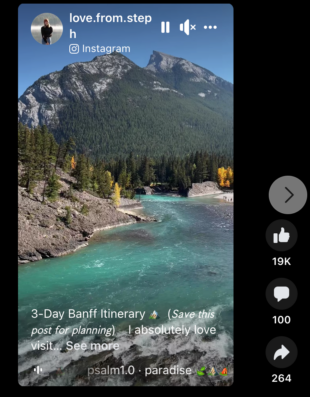
Take advantage of the quick-and-dirty editing tools to make fun, fast content. The secret to Reels, ultimately, is not to overthink it. Quickly stitch together a few videos from an event, share the visual vibe of your product photoshoot, or lovingly prank a co-worker and set the humiliation to a trending song.
Read more about tips for making Facebook Reels that attract attention and engagement here.
How to create a Facebook marketing strategy in X easy steps
1. Define your audience
Before you do anything, you must first define who your ideal potential customer is and what they want on Facebook. Then, create a marketing and content strategy around that.
Every article about social media marketing says this.
…Because it’s true.
At minimum, you need to define your target audience by answering the following:
- What age range do they fall in?
- Where do they live?
- What types of jobs or job responsibilities do they have? (Most relevant for B2B brands.)
- What problem do they have with [your industry/product]? (And how are you the solution?)
- How and when do they use Facebook? (At work, home, doom scrolling before bed?)
Not sure where to start? If you already have followers on your Facebook Page, check out Audience Insights inside Meta Business Suite to see the demographics of your existing audience.
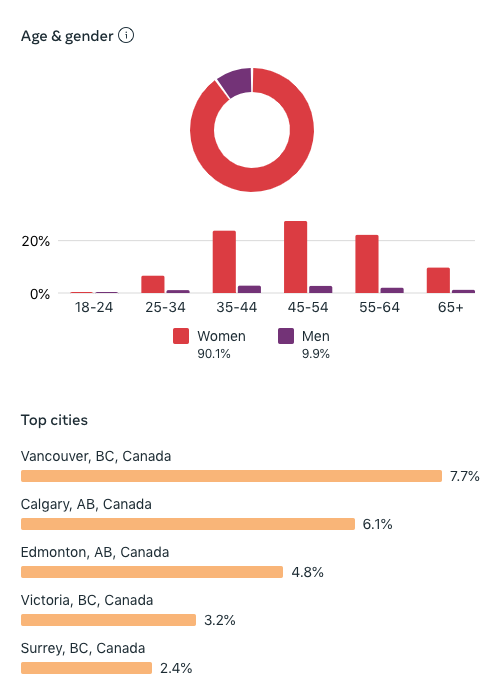
Does your data line up with the customers you want to attract? Perfect, keep up the good work. Not so much? Adjust your content strategy accordingly and watch your Insights to see what works for shifting your audience to the one you want.
This data is also valuable for ad targeting if you want to explore Facebook advertising.
Ready to dig deep? Here’s how to get all the nerdy info you want from Facebook Audience Insights.
2. Define your goals
Why do you want followers? What do you want them to do? For most companies, the answer is, “Buy something.”
But it’s not always about money. Other common goals for a Facebook Page are to:
- Build brand awareness
- Improve customer service
- Maintain a consistent brand image across social media
- Bring in traffic to a physical location
Your Facebook marketing goals will depend on your overall marketing strategy. (Need a refresh? We’ve got a free marketing plan template for ya.)
If you’re up for more no-BS advice, check out this post about setting social media goals and how to measure them.
3. Plan your content strategy
No need to overcomplicate this. Your content strategy is:
- What you’ll post
- When you’ll post it
What to post
Will you share behind-the-scenes glimpses of your process? Will you post exclusive discounts? Will you stick to business or include some fun and games?
Let your imagination run wild with ideas— Ha! Just kidding. You’re gonna post what your audience wants, right? From all that research you did in step 1, right?
Creativity is encouraged, though. Blend what you know about your target audience with what you think will perform well. (Psst—we’ve researched all the best social media trends, so you don’t have to.)
Think of your Facebook content strategy like buckets. Each bucket is a topic.
For example:
- Industry news
- Company news
- Tuesday Tips, where you share a short tutorial for your software
- Reviews/testimonials
- New products and promotions
You get the idea. And you know what makes everything, including creativity, more fun? Rules!
A few classic social media content strategy rules to consider:
- The rule of thirds: One-third of your content is your ideas/stories, one-third is direct interaction with your audience, and the last third is promotional content.
- The 80/20 rule: 80% of your content should inform, entertain, and educate, and the remaining 20% can be promotional.
When to post it
Once you’ve decided what to post, deciding when to post it is the last puzzle piece.
As mentioned earlier, Facebook Audience Insights can help here, although our research has found the best time to post on Facebook is between 8 a.m. and noon on Tuesdays and Thursdays.
Though, of course, that’s a massive generalization. Like everything else in your strategy, experiment! Try different times and see when you get the most engagement.
It’s easy to stay on track with Hootsuite Planner. Everyone on your team can see upcoming posts, collaborate on drafts, and identify any gaps before you reach an oh-crap-I-need-a-post-right-now content emergency. (Hootsuite’s new OwlyWriter AI composer tool can even help you find the right words.)
The best part? Hootsuite’s powerful analytics will tell you when the best times to post are, based on your personalized data.
4. Optimize your Page
Whether you’ve just set up your Facebook business Page or have had one for a while, make sure you have:
- A profile photo—your logo works great—and a cover photo. (Check our social media image size guide for current specs.)
- A call to action button, such as Book Now.
- Contact information, including URL, phone number, and email address.
- A detailed About section.
- A pinned post with your latest promotion, offer, or FAQ.
- A custom Page URL. (For example: www.facebook.com/hootsuite)
- An accurate business category. (Ours is “Internet company.”)
If you have a physical business location, also ensure you’ve added a street address.
If you’re an ecommerce business, use Commerce Manager to display your products in the new Facebook Shop tab. Not sure how? Here’s how to set up a Facebook Shop.
5. Try other Facebook tools
1. Create a Facebook Group
Groups require a lot of moderation and attention to be successful, but they can earn powerful results.
More than 1.8 billion people say they use Facebook Groups every month. These opt-in communities offer businesses a great way to bypass the merciless Facebook news feed algorithm and connect with audiences where they are actually likely to see and interact with branded posts.
Learn more about creating a winning Facebook Group for your Business here.
2. Drive engagement with Hootsuite Inbox
Hootsuite Inbox allows you to respond to DMs and comments from all your social platforms in one place. Besides replying faster, it also enables your entire team to manage communications without duplicating work or missing anything.
See how much time you’ll save:
3. Try Facebook Marketplace for local sales
While you may think of Facebook Marketplace as simply the modern-day alternative to Craigslist, it’s actually a powerful business sales channel, too.
In 2022, Facebook Marketplace ads reached 562.1 million people. While most sellers are people cleaning out their basements, business listings are welcome, including in lucrative categories like car and real estate sales (where regional laws permit).

It’s free to create listings, making it a must-try for local businesses. If you sell nationally, consider promoting your shop website, too.
6. Install Meta Pixel (formerly Facebook Pixel)
Meta Pixel is a small piece of code installed on your website to allow tracking, testing, targeting, and analytics for Facebook and Instagram ads. You only have to set it up once per website. (And wait, you’ve already linked your Instagram account to your Facebook page, right?)
To install Meta Pixel:
1. Log in to Facebook Events Manager. In the left menu, click Connect data sources.
2. Choose Web as the data source and click Connect.
3. Name it and enter your website URL. Depending what your website runs on, there may be a one-click integration available. If not, follow the prompts to install the code manually.
4. Select Conversions API and Meta Pixel or Meta Pixel Only as your setup option and follow the prompts.
If that’s not enough guidance, we’ve got a more robust set of instructions for installing Meta Pixel here.
7. Try Facebook advertising
Facebook ads can skyrocket traffic and sales, but launching a campaign can be overwhelming.
You’re also probably wondering how much Facebook ads cost. (Spoiler: It varies. You’re welcome.)
Facebook ads reach the largest potential audience of any social platform, up to 2.96 billion people as of 2022. Put another way, that’s 36.9% of Earth’s entire population over age 13.
So if you want to begin social media advertising, Facebook is the best place to start for most businesses. There’s a lot to learn, but our step-by-step guide to creating your first Facebook ad campaign makes it easier.
But… are you actually ready?
When to start using Facebook ads
The day after creating your shiny new business Page isn’t the best time to try out Facebook ads. But, letting someone else arbitrarily tell you when you’re ready isn’t the answer, either. (He he he.)
Yep, as with most marketing things, there isn’t one correct answer or KPI that can tell you when to start experimenting with ads.
We’d argue you should have these things first:
- A complete Page (don’t forget to add that profile pic!)
- At least 100 Page Likes (followers)
- Meta Pixel set up
- At least 20 Page posts (ideally more)
- Multiple creative assets for each ad
- An A/B testing strategy
You also should make sure advertising on Facebook aligns with your Facebook marketing goals. Are you interested in extending your reach? Are you digital-advertising curious? Do you want to find new customers? Do you want access to in-depth insights about those customers?
If the answer’s yes to any of these, you’re ready to dive in. But do you want to do this the easy way…. or the hard way?
The easy way: Boost a post
“Boosting” a post is Facebook lingo for taking a regular Page post and turning it into an ad.
Boosting is the gateway ad those senior content marketers warned you about. Side effects of success include conversions, audience growth, and a newfound appreciation for digital advertising.
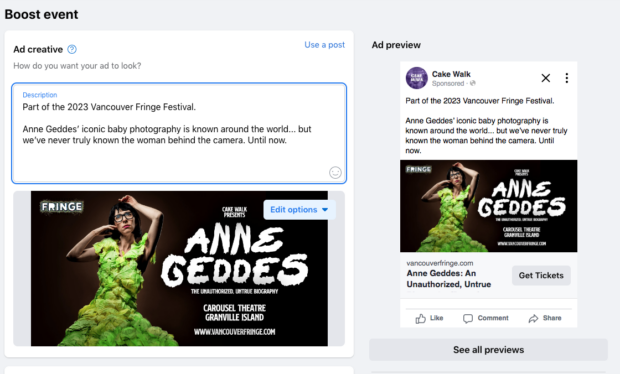
When you should consider it: If you’re completely new to Facebook advertising and want to test the waters. Boosted posts are relatively cheap since you specify your budget upfront. (But remember: Cheap isn’t effective if the ad isn’t accurately targeted.)
Ready to hit turbo mode? Here’s how to boost a Facebook post the right way.
The advanced method: Create your first Facebook ad campaign
Ad groups, creative options, launch dates, awareness ads, conversion ads, multiple formats, copy options… A full Facebook ad campaign is a lot of work.
But we’re here to tell you: it’s worth it. The combination of organic and paid Facebook content is the secret sauce to achieving all your social media ✨dreams. ✨
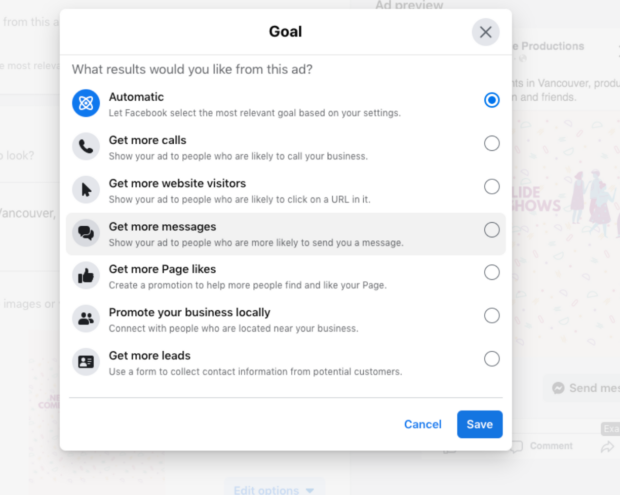
When you should consider it: You want to build focused momentum for a product launch, event, or other promotion.
Paid campaigns can work with budgets of all sizes, but spend time honing your targeting skills first. Experimenting with boosted posts can help dial this in.
You know when you see an ad and think Wow, I’m the target market? Like when an ad for a Millennial-pink saucepan starring Carly Rae Jepsen drops in your Instagram feed? That’s how you want your ad’s viewers to feel: “This is for me.”
You can absolutely be successful at DIY-ing your Facebook ads, although plan to do a ton of research along the way. We have a few resources for you to start with:
Consider hiring an agency or freelance consultant to help plan your first campaign. You’ll learn a lot and optimize your chances of success.
How much does it cost to market on Facebook?
The boring answer is: it depends.
To be clear, many aspects of Facebook marketing are free. You can create and post content all day long without spending a penny. All it might cost you to achieve successful reach and engagement is your time.
But there are absolutely ways to financially invest in your Facebook business marketing strategy, too, by paying to boost your content or creating an ad campaign. You set your own budget for this, so you could have a $5 ad campaign… or you could have a $50,000 ad campaign. It all depends on what type of ads you use and how far you want to reach. We get into all of the ad-price benchmarks here, but the TLDR is that your mileage may vary.
If you’re considering a collaboration with an influencer or creator, you might also want to budget for that too. But again, the amount you’d spend on that will vary wildly, depending on what you’re asking for, and who you’re working with.
Facebook marketing examples for inspiration
Eyewear company TIJN uses the power of humor when it creates Reels. I get a good look at these sweet hot-pink frames and have a laugh that someone has made a sponge into a puppet: win-win! Reels are the perfect medium for this sort of content: lo-fi and friendly, it’s the sort of video your friend might send you… which creates all sorts of feel-good warm fuzzies.
https://www.facebook.com/reel/3255206307950663
Momofuku must’ve spent a fortune on Meta ads because I see this noodle promo six times a day… and dammit, it’s working. I’m not sure if they just literally put my name into the targeting section, but obviously someone put some serious thought into making sure this ad campaign reached only the laziest, carb-obsessiest foodies.
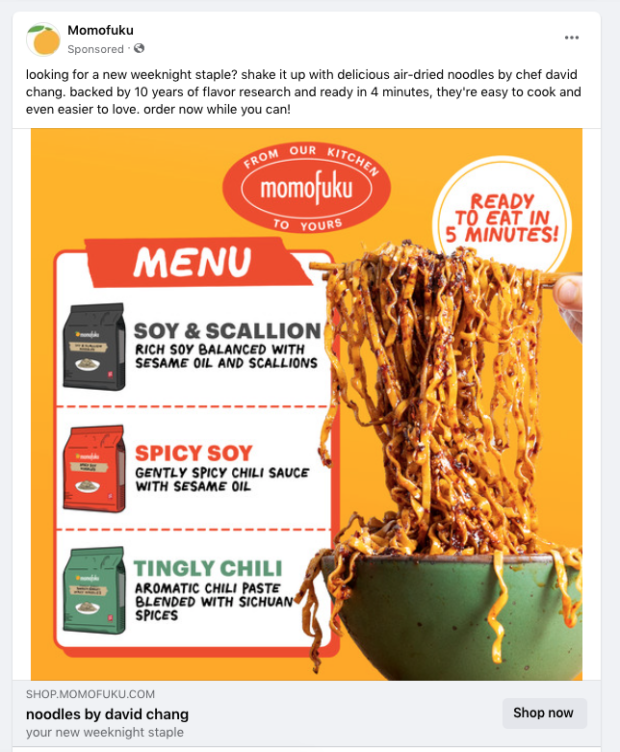
Society6 shares a seasonally appropriate print as a photo in this post but also prompts followers to share their Earth Day celebration plans: a great recipe for engagement.
Starbucks keeps it short and sweet with a text-based post. The sentiment is relatable and personal and taps into the nation’s obsession with pumpkin-spice season. The 95-character post generated 16,000 likes plus thousands of shares and comments.
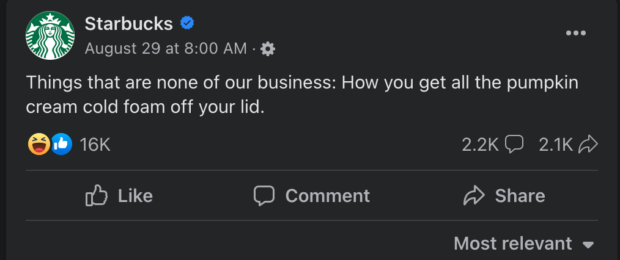
Ikea prompts engagement here by asking followers to weigh in on which photo they like best. (For the record? I’m team B.) Just because photos are static doesn’t mean the post can’t be dynamic and interactive.
Swimwear brand Left on Friday uses Facebook Stories to showcase casual, intimate behind-the-scenes moments at a photo shoot. It’s how everyday people use this feature—your brand can too!
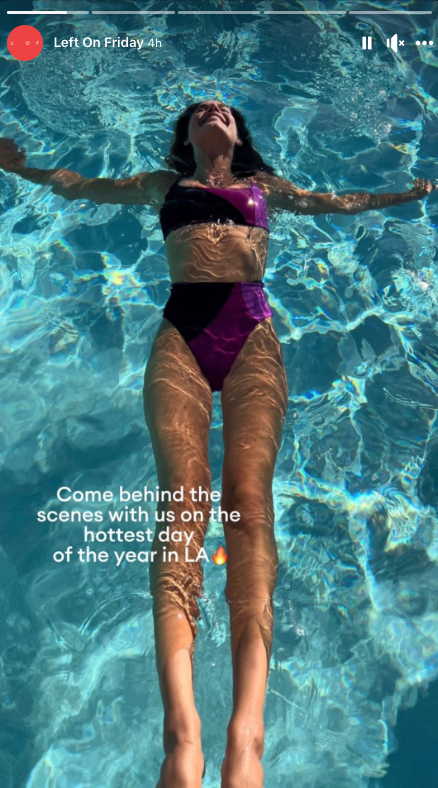
Facebook can be a great place to share links to your content, whether that’s a blog post or an in-depth YouTube video like Fable Home has done here.
6 Facebook marketing tools
1. Hootsuite
With Hootsuite, you can manage all of your Facebook marketing activities from one place. We hate marketing cliches, but it really is your, excuse us, one-stop shop for all things Facebook marketing.
Use Hootsuite to:
- Schedule all of your Facebook posts in advance
- Identify the best times to post (when your unique audience is active online and most likely to engage with your content)
- Review your performance and easily generate comprehensive reports
- Answer comments and private messages
- Boost posts
- Easily track what people are saying about you online
- Manage your Facebook Pages alongside all your other social profiles on Instagram, TikTok, LinkedIn, Twitter, YouTube, Pinterest, and LinkedIn.

2. Facebook Ads Library
Sometimes a little inspiration is all you need. Facebook Ads Library is a searchable database of all the ads currently running on Facebook.
You can filter by location, type of ad, and keywords.
Get ideas for your next campaign, identify trending phrases or graphics, and check up on what your competitors are doing.
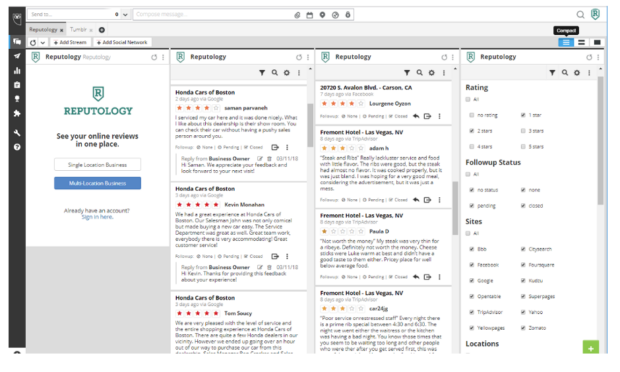
3. Reputology
Reviews are one of the most important aspects of your Facebook Business Page (and elsewhere). Reputology tracks incoming reviews and allows you to respond inside Hootsuite.
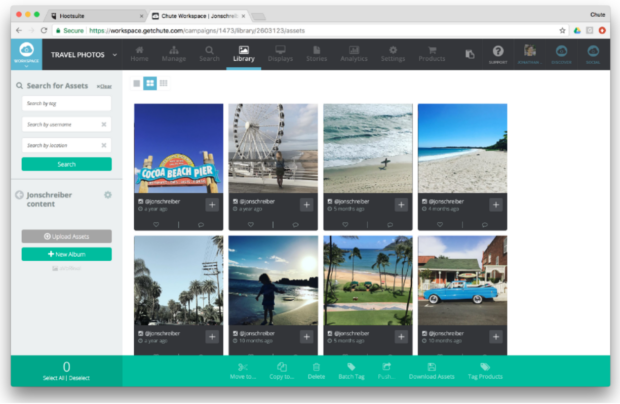
4. Chute
User-generated content is awesome for 2 reasons:
Chute simplifies the often-daunting task of finding relevant content based on topic, location, or more. Save what you find into an organized content library you can access from Hootsuite Composer.
It also makes it easy to properly obtain usage rights and permission for legal compliance.
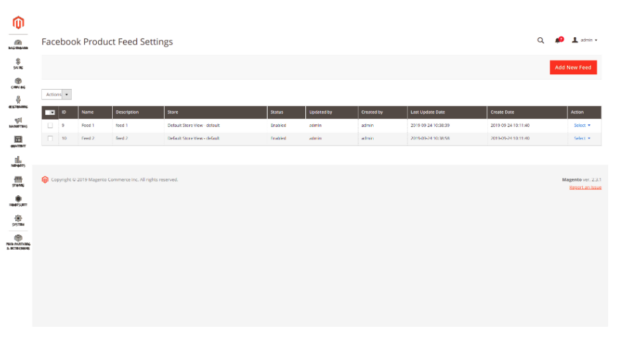
5. Magento
For brands with a Facebook Shop, the Magento integration is a super helpful tool in your toolkit. Easily upload your e-store products to Facebook and use Facebook dynamic ads to scale your ad creation and show relevant products. You can also schedule automated updates of your product catalog and set up multiple feeds for different stores and currencies.
Manage your Facebook presence alongside your other social media channels using Hootsuite. From a single dashboard, you can schedule posts, share video, engage your audience, and measure the impact of your efforts. Try it free today.
Get Started
Grow your Facebook presence faster with Hootsuite. Schedule all your social posts and track their performance in one dashboard.
